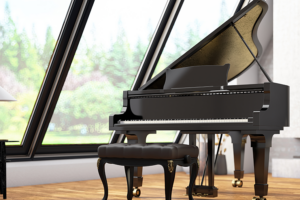Musicians, particularly those who play large instruments, face difficult shipping challenges. Not only is a tuba or cello vulnerable to damage in transit, but they are also sensitive to temperature and humidity changes. In addition, some large instruments, such as floor harps, are too big to be shipped in standard parcels and do not lend themselves easily to being broken down into pieces for shipping.
Air Travel with Instruments
If your instrument has a sturdy case and is a reasonable size, you may be able to travel with it on a flight. Even if your instrument has a hardshell case, it is extremely vulnerable to damage if you check it as luggage. Baggage handlers often have many bags to load within a tight time frame, and are not known to be overly careful or delicate. Your best bet is to bring it to the gate. If size permits, you will be allowed to bring the instrument on as carry-on and store it in an overhead compartment. A flight attendant may accept your larger instrument onto the flight, storing it in a forward closet. The most probably scenario is that your instrument will be checked at the gate, meaning it will be one of the last items on and off, reducing the risk of handling damage.
- Clarify the rules about Instruments with your specified airline by calling or checking online.
- If you check your baggage, make sure to get a claim check.
- Choose flights with minimum stops, which will reduce the number of times your instrument is handled.
- If your instrument is worth more than the airline’s liability limit will cover, purchase “excess valuation” from the airline.
- Check the instrument for damage before you leave the airport. If you notice any damage, take it up with the airline immediately.
Tips for Shipping your Instrument
- For stringed instruments, loosen the strings by one step to protect against temperature and pressure changes. Be sure that you retain some tension, just not the full level.
- If packing to send with a service provider, notify them in advance about any special precautions you would like them to take.
- Make sure that your instrument is properly insured for travel. Your service provider may provide adequate coverage, or you can look to a third party such as uShip Protection Plan for additional coverage.
- Pad your instrument with many extra layers and mark it with “Fragile” labels. If your instrument has any fragile parts, such as the neck of a guitar or violin, pay special attention to wrapping them fully.
- After you receive a wooden or stringed instrument, allow it to spend at least 24 hours acclimating to the temperature and humidity in your home or studio before playing it.
- Ensure that your instrument has a luggage tag with your name, address, and phone number in the case that is misplaced.




